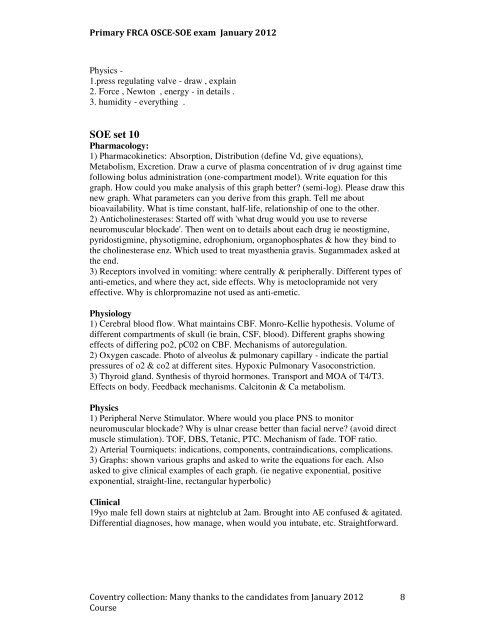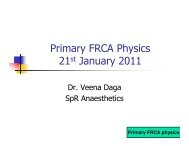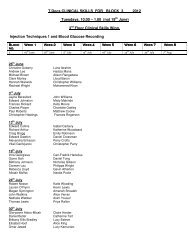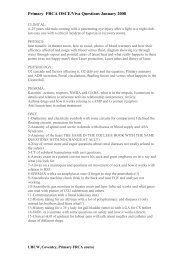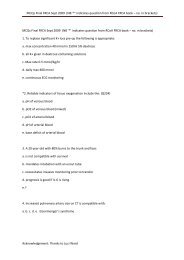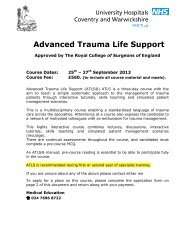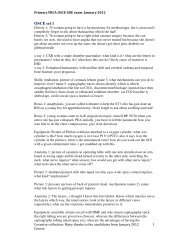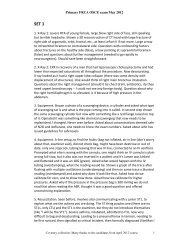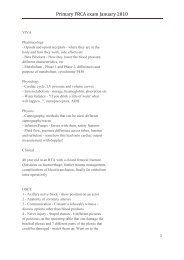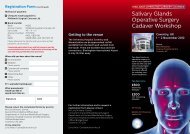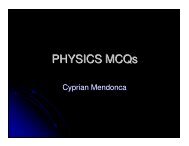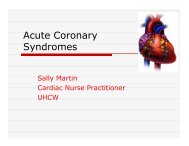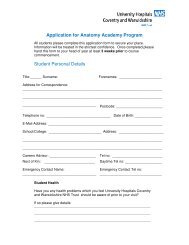Primary FRCA OSCE-SOE exam January 2012 Coventry collection ...
Primary FRCA OSCE-SOE exam January 2012 Coventry collection ...
Primary FRCA OSCE-SOE exam January 2012 Coventry collection ...
You also want an ePaper? Increase the reach of your titles
YUMPU automatically turns print PDFs into web optimized ePapers that Google loves.
<strong>Primary</strong> <strong>FRCA</strong> <strong>OSCE</strong>-<strong>SOE</strong> <strong>exam</strong> <strong>January</strong> <strong>2012</strong><br />
Physics -<br />
1.press regulating valve - draw , explain<br />
2. Force , Newton , energy - in details .<br />
3. humidity - everything .<br />
<strong>SOE</strong> set 10<br />
Pharmacology:<br />
1) Pharmacokinetics: Absorption, Distribution (define Vd, give equations),<br />
Metabolism, Excretion. Draw a curve of plasma concentration of iv drug against time<br />
following bolus administration (one-compartment model). Write equation for this<br />
graph. How could you make analysis of this graph better? (semi-log). Please draw this<br />
new graph. What parameters can you derive from this graph. Tell me about<br />
bioavailability. What is time constant, half-life, relationship of one to the other.<br />
2) Anticholinesterases: Started off with 'what drug would you use to reverse<br />
neuromuscular blockade'. Then went on to details about each drug ie neostigmine,<br />
pyridostigmine, physotigmine, edrophonium, organophosphates & how they bind to<br />
the cholinesterase enz. Which used to treat myasthenia gravis. Sugammadex asked at<br />
the end.<br />
3) Receptors involved in vomiting: where centrally & peripherally. Different types of<br />
anti-emetics, and where they act, side effects. Why is metoclopramide not very<br />
effective. Why is chlorpromazine not used as anti-emetic.<br />
Physiology<br />
1) Cerebral blood flow. What maintains CBF. Monro-Kellie hypothesis. Volume of<br />
different compartments of skull (ie brain, CSF, blood). Different graphs showing<br />
effects of differing po2, pC02 on CBF. Mechanisms of autoregulation.<br />
2) Oxygen cascade. Photo of alveolus & pulmonary capillary - indicate the partial<br />
pressures of o2 & co2 at different sites. Hypoxic Pulmonary Vasoconstriction.<br />
3) Thyroid gland. Synthesis of thyroid hormones. Transport and MOA of T4/T3.<br />
Effects on body. Feedback mechanisms. Calcitonin & Ca metabolism.<br />
Physics<br />
1) Peripheral Nerve Stimulator. Where would you place PNS to monitor<br />
neuromuscular blockade? Why is ulnar crease better than facial nerve? (avoid direct<br />
muscle stimulation). TOF, DBS, Tetanic, PTC. Mechanism of fade. TOF ratio.<br />
2) Arterial Tourniquets: indications, components, contraindications, complications.<br />
3) Graphs: shown various graphs and asked to write the equations for each. Also<br />
asked to give clinical <strong>exam</strong>ples of each graph. (ie negative exponential, positive<br />
exponential, straight-line, rectangular hyperbolic)<br />
Clinical<br />
19yo male fell down stairs at nightclub at 2am. Brought into AE confused & agitated.<br />
Differential diagnoses, how manage, when would you intubate, etc. Straightforward.<br />
<strong>Coventry</strong> <strong>collection</strong>: Many thanks to the candidates from <strong>January</strong> <strong>2012</strong><br />
Course<br />
8


